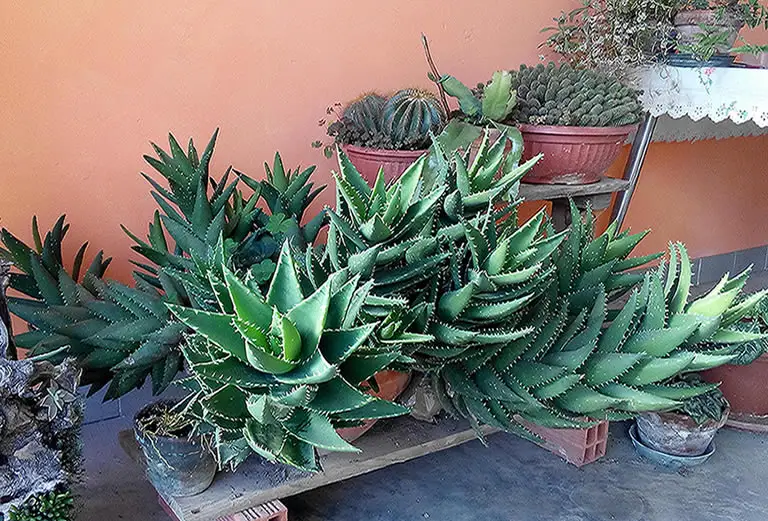In this article I cover everything you need to know about growing aloe vera. I outline the growth stages of aloe vera and give you tips for growing your aloe vera plant bigger and at a faster rate. I also show you how to grow aloe vera from seed and also how to grow it from a cutting.
Table of Contents
Key components to making aloe vera grow fast and healthy indoors
Although I have an article detailing how to grow an aloe plant I wanted to create a specific resource for people who are especially interested in growing aloe vera.
Aloe vera is a species of the aloe plant and a member of the Asphodelaceae family.
It originates from the tropical deserts of the Arabian Peninsula but now grows widely in other tropical, and also subtropical areas around the world.
Aloe vera is just one of the 550 aloe species that are grown today, albeit it is the most popular, so it requires the same care and attention as all other aloe plant varieties.
Aloe vera soil and pot requirements
Aloe vera is a succulent that requires a specific type of soil in order to thrive.
I have found over the years that cactus soil works best for aloe vera.
Cactus soil has just the right amount of nutrients for this desert bloomer to thrive.
It also contains the correct mixture of other ingredients, such as sand and perlite, to allow for good water drainage and to dilute the richness of the soil.
Although I prefer terracotta pots for all aloe plants (as they just look great with succulents and also prevent water retention), you can use a type of common plant container from plastic to ceramic.
However, whichever pot you choose, you ensure it has good drainage.
A pot that has good drainage is essential for aloe vera.
In our aloe soil and pot guide we cover everything you need to know about the soil you need for growing any aloe plant, including aloe vera. This applies to whether you are cultivating an indoor or outdoor plant.
However, be aware that although outdoor aloe vera will need the same type of soil as indoor aloe vera, outdoor plants do require very specific environmental conditions in order to grow.
If you want to grow an aloe vera outside, or even just move indoor aloe plants outside, you must live in the appropriate climate zone.
Most Americans will be unable to successfully grow aloe vera outside all year-round.
See our guide to growing and using aloe plants outside for more information on this.
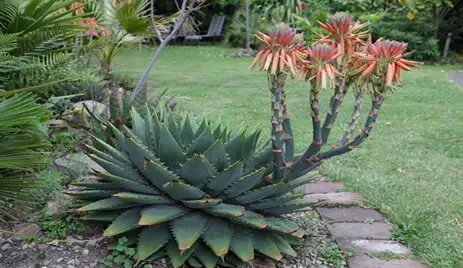
Although there are other important considerations, such as temperature and humidity levels and light requirements (covered below), you will find that by far the most important part of an aloe vera’s care is its watering routine.
Get the watering wrong and nothing else matters.
Aloe vera watering requirements
Although it is possible to underwater aloe vera it is much more likely you will overwater it. So you must be careful with the plant’s watering routine.
Although aloe vera prefers to be watered from the bottom, like all succulents it is a plant that does not like to sit in water for long periods.
The plant has evolved to be perfectly adapted to very warm, water-scarce environments where it can survive for long periods without any water at all.
Therefore too much water can quickly damage or even kill the plant.
When aloe vera is watered too often it develops root rot that essentially dehydrates the plant, as counterintuitive as this may sound.
As the roots rot while sitting in water they become incapable of absorbing moisture and nutrients and thus become unable of distributing water to the rest of the plant.
Thus, essentially starving the plant of food and water.
Read our guide to aloe vera root rot for more in-depth information and treatments for this problem.
There are several symptoms associated with root rot that can manifest in different ways with the most common being a browning of the leaves and/or an unpleasant odor.
To avoid root rot aloe vera should be watered sparingly and as a general rule-of-thumb you should aim to water an indoor aloe vera plant only once every 3 weeks.
However be aware that your specific watering routine may differ depending on the environmental factors the plant is growing in.
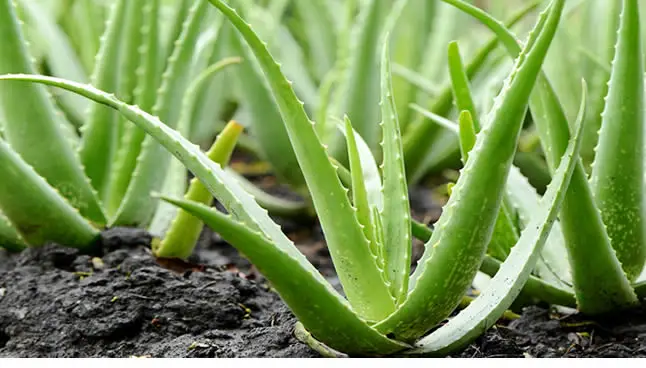 Temperature, sunlight, soil type and even the type of pot you are growing your aloe vera in can all affect the watering schedule of the plant.
Temperature, sunlight, soil type and even the type of pot you are growing your aloe vera in can all affect the watering schedule of the plant.
Read our aloe watering guide for detailed information on the plant’s water needs and also for tips on how to avoid possible problems related to a poor watering routine.
The article also contains ways for dealing with watering problems should they arise.
Aloe vera light & heat requirements
Being a tropical plant that blooms in desert-like conditions an aloe vera requires a certain amount of direct sunlight every day.
If aloe vera gets less than 6 hours direct sunlight per day then the plant will not reach its full potential and it is very unlikely that it will ever bloom.
As most aloe vera plants are grown indoors as houseplants you will usually need to take steps to ensure the plant gets the correct amount of light. Many aloe vera owners will use a small grow light, like this one, that attaches to the plant pot.
Using a grow light ensures the aloe vera gets extra localized light.
These small grow lights are fantastic if you want to keep an aloe vera in a more shaded area of your home.
The extra light provided is also perfect for getting an aloe vera to produce flowers if you find that your plant refuses to bloom.
Typical indoor temperatures for an aloe vera plant should fall into the range of 55° F – 80° F. Most US homes fall nicely into this heat range.
Aloe vera grow naturally in dry climates with normal to low humidity levels.
Most homes are kept at fairly low humidity levels throughout the year.
This means there is no need to create any extra humidity around the plant within your home as you often have to do with other succulents.
For more in-depth detailed information on the proper care of aloe vera read our aloe plant care guide.
The 5 aloe vera growth stages
Below is a quick outline of the growth stages of aloe vera.
The 5 growth stages of aloe vera:
- Germination.
- Growth.
- Blooms.
- Seed production.
- Dormancy.
The germination stage
An aloe vera seed, when planted in the correct soil that is watered to make it moist will germinate.
A root is the first thing to emerge from the seed during germination.
The root will reach down into the soil providing a means for absorbing nutrients and moisture for distribution to the emerging leaves.
It also acts as an anchor for the young plant.
The active growth stage
Once the seed has developed a root it will begin to produce tiny leaves that break through the soil as they reach upward toward the light.
Once the initial seedlings have broken through the top layer of soil the plant will go into an increased growth stage.
During the leaf growing season (spring, summer, autumn, winter), the foliage will start to take its unique and familiar form.
A rosette of pointed fleshy leaves will be visible.
Being a desert plant that grows in areas where resources are scarce the aloe vera has developed some forms of self-defense to protect itself against natural predators.
Each aloe vera leaf develops edges that have prickly spines on them.
These grow in order to discourage animals from eating the plant and harvesting the water and nutrients stored in the leaves.
When the foliage grows to maturity many aloe vera owners will cut the leaves to harvest the latex it contains for home-remedies usually associated with skin care.
The blooming stage
Aloe vera will bloom at different times in different environments.
Climate plays a huge role in the timing of aloe vera blooms and even if it blooms at all.
Even indoor aloe vera plants will bloom at different times in different climate zones. The only exception is when deliberate action is taken by the plant owner to regulate the environment and thus the bloom cycle via things like grow lights for example.
For information on when you can expect your aloe vera to bloom read our guide to aloe blooms and aloe vera flowers.
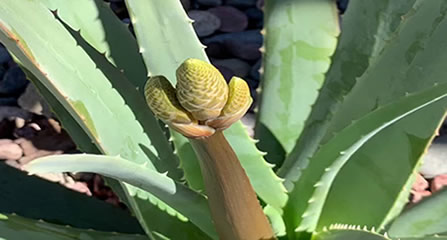
When an aloe vera plant enters the blooming stage it will produce a tall and slender flower spike which grows directly from the center of the rosette leaves.
From the very tip of this flower spike a cluster of yellow, tubular-shaped flowers will form and grow.
On normal circumstances this is the only time you should fertilize an aloe vera plant and you should do it only once.
Aloe vera are light feeders and can thrive on very limited nutrients.
Over fertilization can lead to problems with the plant.
When it comes time to feed your aloe vera a normal household fertilizer will suffice though I prefer to use a high quality succulent fertilizer for my aloe vera.
Regardless of which fertilizer you use, and this includes succulent fertilizers, always only make it up to half the strength recommended on the product label. Always do this when feeding aloe vera or any other aloe plant!
Being a perennial a mature aloe vera plant will bloom once per year as long as conditions are right.
During the warmer months, when most aloe plant will bloom, a mature aloe plant can also produce offsets to the side of the main plant.
These are actually small newly formed plants that can be removed from the parent plant and grown separately to cultivate new aloe vera plants.
Just be sure that when you remove an offset you also remove some of the roots that are attached to it.
Be aware that only mature aloe vera plants will bloom.
It takes about 4 years for an aloe vera plant to mature enough to be able to produce flowers (and also offsets).
Although insufficient direct light is the biggest reason for a lack of aloe vera blooms, plant immaturity is sometimes the cause.
In many non-blooming aloe vera trouble-shooting cases that I have been involved in I discovered that the aloe vera in question was actually an immature plant that was incapable of blooming and there was no problem at all.
Seed production
In its native habitat an aloe vera is usually pollinated by insects and small long beaked nectar-eating birds (such as sunbirds in Africa and hummingbirds in America).
A pollinated aloe vera flower will develop small green pods that contain seeds.
As a pod ages it will dry and turn a brown-like color before splitting open and releasing the contained seeds which fall to the ground below.
These aloe vera seeds can remain dormant for some time and will only germinate when the conditions are right.
Dormancy
In the colder months aloe vera will go dormant for a period of a few months where there is no new growth.
During dormancy an aloe vera plant requires very little care and it should only be watered when the soil dries out.
Maintaining the same watering routine when the plant goes dormant will likely lead to overwatering and so watering the plant should be avoided unless the soil is dry.
Overwatering aloe vera during its dormant phase will then likely lead to root rot and the death of the plant.
After the dormancy period the aloe vera will enter a new growth stage where it produces new foliage.
A well-cared-for aloe vera plant can live for many decades and continue to bloom year-on-year.
How fast you can expect aloe vera to grow
How fast can you expect a newly seeded, or propagated, aloe vera to grow … how fast does aloe vera grow?
On average aloe vera grows from seedling to full plant in about 4 months.
Then it will produce a new leaf from the center rosette once per month.
However, it takes aloe vera 4 years to fully mature.
Only mature aloe vera plants can bloom. This applies to both indoor and outdoor aloe vera.
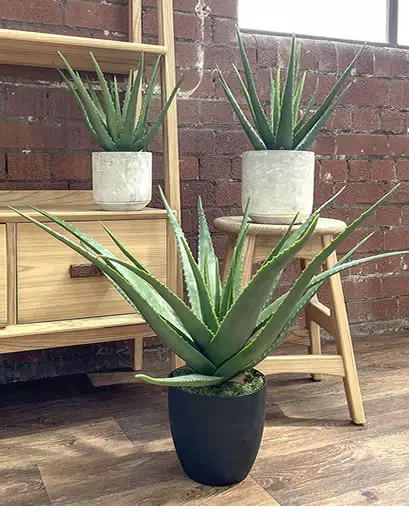 Although an aloe vera plant will produce full foliage fairly quickly in a matter of about 4 months it does take time for the plant to reach full maturity.
Although an aloe vera plant will produce full foliage fairly quickly in a matter of about 4 months it does take time for the plant to reach full maturity.
Only after the plant has matured can it produce flowers.
It is also only when the plant is mature that it can produce offsets which can be used to propagate new plants.
So although you can grow an aloe vera fairly quickly it will take several years before you will see the plant bloom.
There is good news though; an aloe vera plant can live for decades and produce blooms every year once it has matured.
How to make aloe vera grow faster
Some indoor gardeners like to work in a hurry.
Waiting 4 months for their aloe vera plant to grow seems unreasonably long to them (though it’s really not).
So, how can you make your aloe vera grow faster?
You can make an aloe vera grow faster by ensuring the plant has optimal growing conditions and by giving it extra light and the careful addition of fertilizer.
However, there is no way to speed up the maturity time for the plant and you will still have to wait about 4 years before the plant produces flowers.
The best way to get your aloe vera plant growing as fast as possible is to ensure it is growing in the correct conditions.
To give n aloe vera the best chance of growing fast you must therefore ensure the plant:
- Has the correct soil.
- Is growing in the correct pot.
- Gets sufficient amounts of direct sunlight, or artificial light, daily.
- Is growing in an environment that has the correct temperature.
- Is watered correctly.
Only when the above factors are correct should you consider using additional light and fertilizer to speed up an aloe vera’s growth.
Aloe vera plants grow fairly quickly and only need about 4 months to produce a fully grown plant even when grown from seed.
But the conditions for the plant should be optimal before you embark on a quest to speed things up.
Read the above sections of this article to ensure you have given your aloe vera the best environment for fast growth before trying the tips below.
Using artificial light to speed things up
Aloe vera grow best in strong direct sunlight. This plant requires at least 6 hours of direct light per day to grow healthily.
If an aloe vera does not receive at least 6 hours of direct light per day its growth will be slowed down and may even stop.
It will never bloom under this type of restricted lighting.
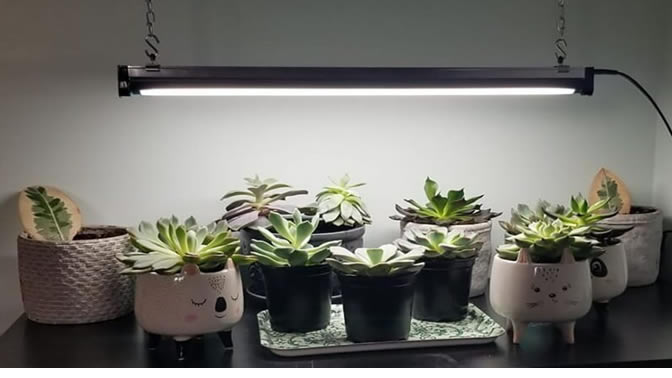 Although it is possible for an aloe vera to experience leaf burn due to too much direct strong sunlight this is rare.
Although it is possible for an aloe vera to experience leaf burn due to too much direct strong sunlight this is rare.
I find that the more sun the plant gets the better it grows and the faster it grows.
To increase the growth rate of an aloe vera it is best to move the plant to an area that gets about 8 – 10 hours of good direct light per day.
If this is not possible then you can use a grow light to increase the amount of light your plant is getting.
This will greatly increase the rate at which the plant grows.
Although most standard grow lights designed for houseplants will work well, I prefer to use individual grow lights like the one I linked to previously.
Alternatively you can use something like this stylish one which fits directly above the pot and also adds to the overall décor effect of the plant.
By using individual grow lights I can regulate amount of artificial light a single plant gets and I believe they look much better than the larger lights used for multiple plants.
Using fertilizer to increase growth speed
You must be very careful when using fertilizer with aloe vera, or any aloe plant for that matter.
These desert succulents have evolved to be very well-adapted to scarce-resource conditions and so do not need a lot of feed.
Normally you would only fertilize an aloe vera once per year during blooming season.
However, to help speed up growth you can use extra fertilizer to stimulate new growth quicker thus reducing the amount of time it takes to get to a fully grown plant.
Use a good succulent fertilizer or one that is specifically designed for cacti.
Always dilute the fertilizer to half the strength that is recommended by the manufacturer on the product label.
This is important!
Aloe vera are very light feeders that normally only need to be fertilized once per year and they only need half the feed that most other succulents need.
Even mature plants require only half strength feed.
However, when trying to speed up the growth of an aloe vera you can feed it twice per month during the growing season. Be conscious of the fact that you must ensure the pot has very good drainage though.
Also be prepared to wash the soil clean (or even repot the plant) if the leaves show signs of leaf burn due to over-fertilization.
If you are careful you should see a increase in the growth of the plant fairly quickly.
Be sure not to fertilize your aloe vera at all during the winter months when the plant will stop growing.
Fertilizing and watering during this dormancy phase will lead to root rot and the death of the plant.
Bear in mind though that no matter what steps you take you cannot speed up the maturity process of an aloe vera.
It will still take 4 years for a new plant to mature enough to where it can produce a bloom.
Aloe vera length & width guide
You may have noticed that many aloe vera plants have different sizes.
Even aloe vera that are the same age and are grown in similar areas may be different sizes.
So, how big does aloe vera grow?
Although a mature aloe vera plant can grow up to 3 feet the average height of an aloe vera is between 1 – 2 feet tall with a width of 24″.
An average fully grown indoor aloe vera plant will have leaves that are 8″ – 10″ in length.
A mature aloe vera will, on average, grow to a height of between 1 – 2 feet with an average width of 24″ (60 cm) though there are steps you can take to make the plant grow bigger.
How you can make you aloe vera grow bigger
What steps can you take to make an aloe vera grow bigger?
You can use artificial light and specific fertilization techniques to make an aloe vera plant grow bigger.
You must also repot the aloe vera into a bigger container to allow for increased root growth.
The first step to making an aloe vera grow bigger is to repot it into a bigger container.
For increased foliage growth the plant requires more root growth in order to feed the extra mass of the plant.
It is therefore essential to give the aloe vera room to grow.
Once reported you can use the light and fertilization techniques mentioned in the above section (used for speeding up the growth of the plant).
This would mean using artificial light sources, such as grow lights, and also feeding the aloe vera twice per month (with diluted fertilizer) during the growing season.
Review the above sections for more detailed instructions.
How aloe vera naturally spreads
Now that you understand the growth cycles of an aloe vera and how it grows you may be wondering why your aloe vera is growing outward.
How does an aloe vera spread?
An aloe vera spreads when a mature plant produces offsets.
These offsets are mini plants that grow to the side of the plant spreading it outwards.
An offset is essentially a clone of the parent plant and can be removed and potted separately to produce an entirely new plant.
An aloe vera has two mechanisms for propagating.
As I mentioned earlier, the flower of an aloe vera will produce seeds, each of which is capable of producing a new aloe vera plant.
But this is not the only way an aloe vera propagates the species.
When an aloe vera plant has matured, after at least 4 years, it is capable of producing offsets.
These offsets grow to the sides of the main plant and usually emerge from the soil looking like new plants rather than new growths from the main plant.
As more and more offsets grow and start to mature it looks as though the aloe vera plant is spreading outwards (which it basically is).
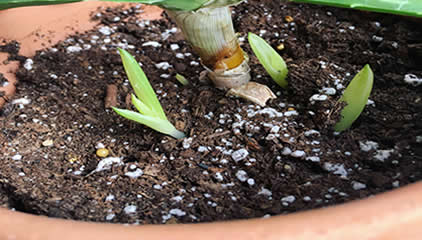
These offsets can be removed from the plant and repotted to produce new plants because each one is a full clone of the parent plant it has grown from.
It is simple to remove the offsets.
First remove the entire plant from the soil.
Then using a sharp knife simply cut away the new growth (the offset), ensuring you also cut away part of the roots of the plant so that they remain attached to the offset.
This sounds harder than it is. You can review exactly how to do this and also see images of what way to do it here.
How to grow aloe vera from seed or cutting
Below I will quickly cover the basics of growing aloe vera from seed and also propagating a new plant from a leaf cutting.
Starting from seed
Is it possible to grow aloe vera from seed?
You can grow aloe vera from seed very easily.
As long as you ensure you are using the correct soil with the right moisture levels, have sufficient lighting in an environment with the correct temperature, aloe vera are very easy to grow from seed.
Below I will show you how to grow aloe vera from seed.
How to grow aloe vera from seed
To grow aloe vera from seed you must have the correct ingredients and tools.
You will need:
- Succulent soil made up of compost, perlite and sand. Cactus soil works great.
- Small plastic containers or plastic grow pots.
- Tenting or plastic bags.
- Good grade aloe vera seeds.
Although it is possible to prepare aloe vera soil yourself (as I demonstrated how to do in the aloe plant soil guide) any good cactus soil will do the job well.
Begin by placing the soil into plastic containers or small plastic pots ensuring that whatever container you use it has good drainage.
I usually prepare about five containers as this gives me the greatest chance of a few of them producing healthy growths.
If you do this the right way though, two containers will usually be more than enough.
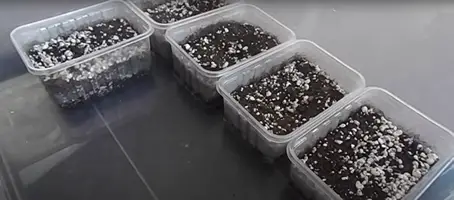
Once filled with soil set the containers into a water-filled large container or into the kitchen sink filled with about an inch of water.
The aim is to have enough just enough water to allow the soil to slowly soak it up from the bottom until the soil becomes moist. But you do not want to add so much water that it spills over the sides of the container and soaks into the soil over the container lips.
Let the containers soak for 15 – 20 minutes or less if the soil gets moist quickly.
Once the soil is moist remove the containers from the water and allow them to drain before sowing the aloe vera seeds.
Aloe vera seeds are small but they are usually big enough to plant by hand.
The seeds should be sowed evenly apart with about 1″ between each seed.
You can use a folded piece of paper with the seeds on it and gently shake them onto the soil if the seeds are particularly small or, like me, you have chunky fingers.
The seeds can be left to sit on top of the soil though you may want to press any larger seeds you come across slight deeper into the soil.
Now that you have seeded the soil you should place a tent (like this one) over the containers to lock in heat and moisture and also to protect the seedlings as they grow.
Alternatively you can place a separate clear plastic bag over each container individually.
The containers should be placed in a well lit area that gets at least 6 hours of direct light per day.
I personally use a grow light to give the seeds extra light and warmth so they have the best chance for germination and growth.
There should be more than enough moisture in the containers for germination and seedling growth. This is because the water in the soil will evaporate but remain in the local environment due to the tent (or plastic bag).
After a few weeks you will see new shoots emerge from the soil.
Once the new seedlings have grown to a about 2 – 3 cms high you can remove the tenting if you wish or leave it in place until the plants are a little more established.
When the plant starts to take on the recognizable shape of a small aloe vera, repot it into its permanent container.
Growing aloe vera from cutting – is it even possible?
So we now know that we can grow aloe vera from seeds and also from offsets but can you grow aloe vera from a cutting?
You can grow aloe vera from a leaf cutting but it is the most difficult way to grow the plant.
It is better to grow aloe vera from seed or propagate it from an offset rather than trying to root a cutting.
You can use specific techniques to increase your chances of growing a plant from an aloe vera cutting however.
Although I discourage people from propagating aloe vera via cuttings, because it is the most unsuccessful method for growing this succulent, it is not impossible to cultivate a mature plant from a simple leaf cutting.
Below I outline the process for growing aloe vera from a leaf cutting.
An aloe vera cutting placed in soil rarely roots
Aloe vera leaves rarely root when placed directly into soil even when using hormone growth powder or gel.
9 times out of 10 the leaf will simply rot before it has time to root.
If you insist on trying to propagate aloe vera from leaf in soil then be sure to allow the leaf a few days to dry out before potting it.
As a general rule you will know the leaf has dried enough when the leaf develops a film over the area that was cut.
Only then should you pot the cutting.
You should also try to propagate several leaves at once to give yourself a higher chance of success as most of them will die before they root.
The best way to increase your chances of successfully growing aloe vera from a leaf cutting is to put it in water.
Although aloe vera plants will develop root rot if left sitting in water, or water-heavy soil, the best way to root a leaf cutting is via a water-based growing medium.
Growing an aloe vera leaf in water will give you more rooting success
It is fairly easy to root an aloe vera leaf in water.
Simply take the freshly cut aloe leaf and place it in a container filled with water that has a little floral feed or liquid growth hormone mixed in.
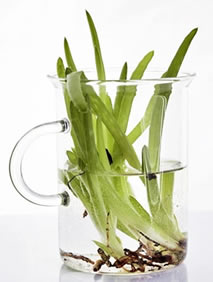
Once placed in the water make sure the cutting gets plenty of light. If possible ensure it gets about 8 hours of direct sunlight per day.
Alternatively use a grow light.
Change the water every 2 – 3 days as the water will lose oxygen over time.
Remember to mix some floral feed or liquid growth hormone in with the fresh water each time.
Once the leaf starts to form new roots remove it from the water and put it in a pot with fresh soil.
I always add some rooting powder and rooting gel to the area of soil where I will place the cutting before putting it in as this gives the new plant the best chance of survival.
As I said previously growing an aloe vera plant from a cutting is the least effective way of growing an aloe vera plant.
It is much more likely to cultivate a successful healthy plant if you grow aloe vera from seed or by propagating it from an offset. However, don’t be afraid to try this method as the feeling of accomplishment you get when you cultivate a new plant this way is amazing.

